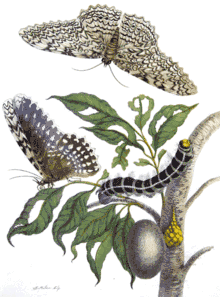Thysania agrippina
Thysania agrippina is a species of moth in the family Erebidae first described by Pieter Cramer in 1776. The most commonly accepted English name is the white witch. Other common names include the ghost moth, great grey witch and great owlet moth. Thysania agrippina is of interest as a competitor for title of "largest insect". This may be true by the measure of wingspan—a Brazilian specimen with a wingspan of almost 30 cm (12 in) appears to hold the record.[1] The Atlas moth and Hercules moth, however, have greater wing areas.[1] The white witch occurs from Uruguay to Mexico, and appears as a stray as far north as Texas in the U.S.[2] Collection dates shows no discernible pattern with respect to location or season.[3]
| White witch | |
|---|---|
 | |
| Scientific classification | |
| Kingdom: | Animalia |
| Phylum: | Arthropoda |
| Class: | Insecta |
| Order: | Lepidoptera |
| Superfamily: | Noctuoidea |
| Family: | Erebidae |
| Genus: | Thysania |
| Species: | T. agrippina |
| Binomial name | |
| Thysania agrippina (Cramer, 1776) | |
| Synonyms | |
| |
History
One story of the derivation of the common name: early naturalists collected specimens of birds and bats with shotguns. An enormous darting flyer high in the canopy was a tempting target. Firing a cloud of pellets at a white witch moth did not necessarily bring it down, however, because the body is small relative to the wing area. The moth would sail along, an unkillable witch.[4] This moth is of historical interest as the subject of a well-known painting by the artist Maria Sibylla Merian. Merian was an insightful naturalist who advanced the 18th-century understanding of insect life cycles; however, her depiction of the white witch life cycle is inconsistent with the known biology.

Ecology, natural history
Given the enormous geographic range of the adult, and observations that date back 300 years, it is striking that the immature life stages of this species have never been documented (notwithstanding the erroneous Merian painting). Long migratory flight is likely, given that the close relatives Thysania zenobia (the owl moth) and Ascalapha odorata (the black witch) are known for flights that reach far north of the host plant distributions. Based on the larval host plants recorded for the owl moth and black witch, the larval host plants for the white witch are probably also woody members of Fabaceae (subfamily Caesalpinioideae), possibly Senna and/or Cassia.[6]
White Witch Watch[7] is a project led by the lepidopterist David L. Wagner at the University of Connecticut, seeking to identify the immature stages of the white witch. A key strategy: to obtain a gravid female and attempt rearing on likely hosts. The participants maintain a website, and an active citizen science project on iNaturalist.
Taxonomic status
Conventionally, "white witch" refers to two very similar species of Thysania listed in the GBIF database:[8] T. agrippina and T. pomponia (T. zenobia is a third morphologically distinct species). However, a 2016 publication[9] establishes a new species among the subset of moths previously identified as T. agrippina. Thysania winbrechiini is differentiated from T. agrippina by morphological features and DNA evidence. T. winbrechiini is further categorized as containing two subspecies, and the authors also define a subspecies of T. agrippina, T. agrippina siriae. A note of caution: There is a concern among taxonomists about the pace at which limited data are being used to describe new species, by authors with a penchant to publish in obscure journals.[10] That concern has been raised in the case of several hundred "Brechlin and Meister species",[11] which are often nominated on the basis of DNA alone.
See also
- Ascalapha odorata, the black witch
- List of largest insects
References
- Kons, Hugo Jr. (17 May 1998). "Chapter 32 — Largest Lepidopteran Wing Span". Book of Insect Records. University of Florida. Archived from the original on 2 March 2008. Retrieved 21 October 2013.
- Distribution map of T. agrippina
- "Blog". White Witch Watch. Retrieved 13 December 2018.
- "The search for the White Witch moth". Livinginperu.com. 12 June 2015. Retrieved 13 December 2018.
- Host information
- Robinson, Gaden S.; Ackery, Phillip R.; Kitching, Ian J.; Beccaloni, George W.; Hernández, Luis M. (2010). "Search the database - introduction and help". HOSTS - A Database of the World's Lepidopteran Hostplants. Natural History Museum, London.
- "The white witch, Thysania agrippina". White Witch Watch. Retrieved 13 December 2018.
- "Thysania Dalman, 1824". GBIF. Retrieved 5 January 2019.
- Brechlin, Ronald; Van Schayck, Eric (May 2016). "Three new taxa of Thysania Dalman, 1824 allied to T. agrippina (Cramer, 1776)". Satsphingia. 9 (2): 28–33.
- Jones, Benjamin (7 September 2017). "A Few Bad Scientists Are Threatening to Topple Taxonomy". Smithsonian.
- "Brechlin & Meister Species". Breedingbutterflies.com. 5 April 2018.
External links
| Wikimedia Commons has media related to Thysania agrippina. |
- White Witch, Texas Entomology page authored by Mike Quinn
- White Witch Watch, a project seeking to determine T. agrippina life history